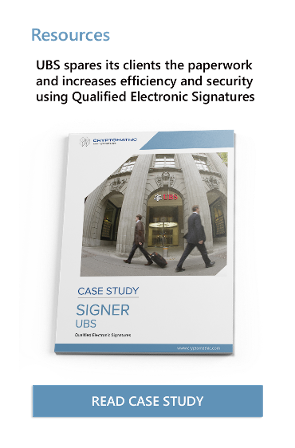3 min read
How FinTechs can benefit from the European eIDAS Regulation
Cryptomathic : 25. September 2021

- Home >
- How FinTechs can benefit from the European eIDAS Regulation
The financial service industry has always been innovator in technology adoption. This is not surprising considering the nature of the industry with high volumes, the need to complete transactions as quickly as possible, mountains of data, minimum tolerance for errors, and multiple points of failure. A zero-tolerance compliance/regulatory environment, coupled with considerable inertia in the banking system, further necessitates the need to use tech tools to their full potential. This reliance on technology by the financial services sector is perhaps why FinTech start-ups are in so much demand.
FinTech ventures are mixing traditional financial services products with a technology approach pioneered by the tech giants of today. This enables FinTech companies to offer innovative new products with significantly greater insight and execution speed than traditional financial services companies. Of course, banks can do the same, but they frequently lack the agility of these smaller challengers and their single-minded focus.
 Helping carry the load
Helping carry the load
eIDAS offers a variety of tools to help FinTech companies make the most of their inherent advantages:
- The most evident benefit of eIDAS is the authentication and identification of users. Security is the top priority for both users and providers of financial services, and eIDAS can go a long way toward delivering pertinent safeguards.
- eIDAS can also assist FinTech firms to tackle one of the most laborious aspects of financial service delivery – regulatory compliance. From KYC (Know Your Customer) guidelines to AML (Anti Money Laundering) checks, it takes a lot of time and effort to ensure nothing fishy is happening. The penalties for being lax here can be enormous. However, eIDAS can ensure complete KYC and AML compliance in an entirely digital environment. Not only would eIDAS enabled checks be quicker, but they are also likely to offer an even greater degree of security and certainty about the client.
- Innovation is the name of the game with FinTech. The European Commission seems to be cognizant of this fact, and eIDAS is the ideal tool for the task. The great thing about eIDAS is technological neutrality. This means that solutions can take a variety of different approaches, and use different technologies as long as the end result and the level of assurance provided is the same. This relieves FinTech firms and allows them to develop their own innovative solutions using a variety of technologies or practices.
- Having complete legal certainty about fully digital services has also been a tricky area for FinTech firms. The eIDAS directive provides legal clarity for electronic identification, authentication, and trust services. This can go a long way in assuring customers of the services offered by FinTech firms and save some legal costs for the service providers.
Conclusion
eIDAS provides powerful tools not only to the existing financial services behemoths but also to new FinTech start-ups. In fact, it goes a long way to level the playing field by allowing start-ups to offer industry-leading safeguards to their potential customers. eIDAS enabled tools can thus ensure that new FinTech firms can compete with the largest banks when it comes to security. And because security is the top priority for the majority of customers, this can be a game-changer.
References and Further Reading
- Digital Trade and Trade Financing - Embracing and Shaping the Transformation (2018), by SWIFT & OPUS Advisory Services International Inc
- REGULATION (EU) No 1316/2013 establishing the Connecting Europe Facility, amending Regulation (EU) No 913/2010 and repealing Regulations (EC) No 680/2007 and (EC) No 67/2010(12/2013), by the European Parliament and the European Council
- Selected articles on Electronic Signing and Digital Signatures (2014-today), by Ashiq JA, Gaurav Sharma, Guillaume Forget, Jan Kjaersgaard , Peter Landrock, Torben Pedersen, Dawn M. Turner, and more
- Selected articles on Authentication (2014-today), by Heather Walker, Luis Balbas, Guillaume Forget, Jan Kjaersgaard, Dawn M. Turner and more
- The European Interoperability Framework - Implementation Strategy (2017), by the European Commission
- Proposal for a DIRECTIVE OF THE EUROPEAN PARLIAMENT AND OF THE COUNCIL amending Directive (EU) 2015/849 on the prevention of the use of the financial system for the purposes of money laundering or terrorist financing (2016), by the European Commission
- REGULATION (EU) 2016/679 on the protection of natural persons with regard to the processing of personal data and on the free movement of such data, and repealing Directive 95/46/EC (General Data Protection Regulation) (2016), by the European Parliament and the European Council
-
Proposal for a REGULATION concerning the respect for private life and the protection of personal data in electronic communications and repealing Directive 2002/58/EC (Regulation on Privacy and Electronic Communications), (2017), by the European Parliament and the European Council
- Revised Directive 2015/2366 on Payment Services (commonly known as PSD2) (2015), by the European Parliament and the Council of the European Union
- REGULATION (EU) No 910/2014 on electronic identification and trust services for electronic transactions in the internal market and repealing Directive 1999/93/EC (2014) by the European Parliament and the European Commission
-
DIRECTIVE 2013/37/EU amending Directive 2003/98/EC on the re-use of public sector information (2013) by the European Parliament and the Council
Image: // OBSERVE // RARE ARCHITECTURE // The Metropolitan Building // BY LORD FOSTER // Warsaw // Poland // Beautiful curves in the heart of the Capital City //, courtesy of || UggBoy♥UggGirl || PHOTO || WORLD || TRAVEL ||, Flickr (CC BY 2.0)
